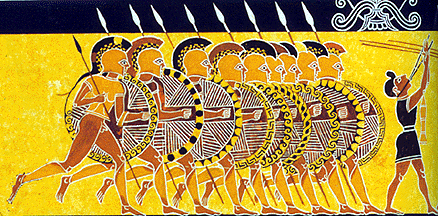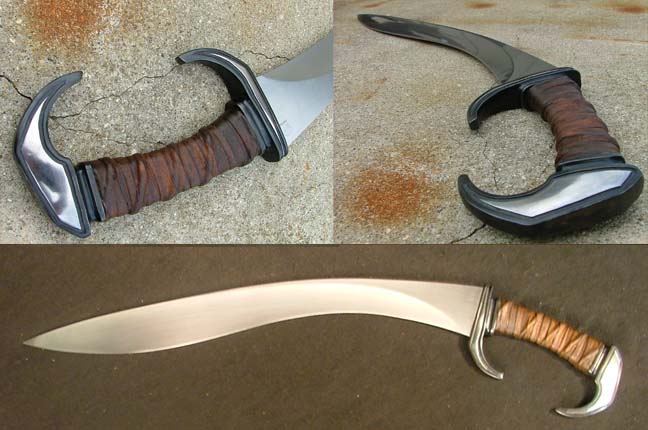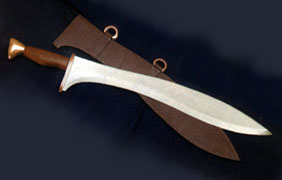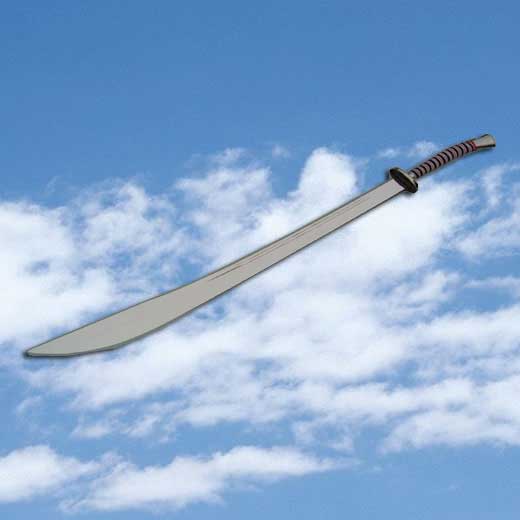The Greek Swords
The Greeks known for big achievements in politics, mathematics, sculpture, literature and philosophy, were fearsome warriors as well. There have been few military units as devastating in their time as the Greek phalanx. Heavily armored and insanely well trained, these soldiers were capable of standing against any and all challengers. Fighting for one's country was an unswerving responsibility among the Greek city-states. Even the poets of the time were tough bastards; most of them wrote only of warfare, courage, resolve and beating the snot out of your enemies.
Greek warriors fought in a phalanx; a unit of heavily armored men that fought in rows, with large shields (hoplons), long spears and short swords.

The Greek swords were dual-purpose weapons with leaf-shaped blades. These blades were designed for both cutting and thrusting. Above all else, the Greek hoplite was a spearman protected by his bronze-covered shield, fighting in a phalanx of spearmen formed up in a line so many ranks deep.
Greek swords usually feature fancy hilts and a scabbard decorated with ancient Greek scenes. They were often gold finished honoring one of the ancient world`s greatest warrior kings - Alexander. This sword commonly called a hoplite sword was named after the heavily armed Greek foot-soldier of the classical period. The hoplite sword was essentially a slashing weapon and was generally worn slung from a baldric over the right shoulder so that it hung almost horizontally on the left. The Greeks used Machaira and Xiphos for describing sword. They were made to a high quality from high carbon steel and twice tempered to achieve a high Rockwell hardness, before being polished.

The Machiara and the Falcata (different names for similar swords) were effective and devastating weapons and quite capable of shearing a bronze helmet. The Greeks were feared warriors, with spear and shield being the primary weapon and armor.

However, once the battle had joined and became hand-to-hand, the Machaira and the sword were available to strike terror into the toughest foe. Witness the destruction of the Persians in their abortive attempts to conquer the Greek city states.
Thus, paradoxically, although sword fighting was not taught during basic training, it required much more skill and training than spear fighting. Hence a demand arose for extra private tuition in skill-at-arms, in which sword fighting played an important part. Parents with sufficient funds were more than willing to pay for this extra instruction. Instructors, known as hoplomachoi, 'fighters in arms', are first mentioned in literary sources located in the last quarter of the fifth century BC. We know of five hoplomachoi from this period by name: Stesileos, the brothers Euthydemos and Dionysodoros of Chios, Phalinos of Stymphalos (who later served as military adviser to the Persian General Tissaphernes at the battle of Cunaxa in 401 BC) and Diomilos of Andros.
The first type is best described as a recurved sabre. Shaped like a Gurkha kukri or a yataghan, the back of the blade curves forward, and the main weight of the weapon lies near the tip. The cutting edge is on the concave side. The hilt sometimes ends in the shape of a bird or animal head, or curves back to guard the knuckles in the shape of a 'knuckle-duster'. The weapon is often shown being used in a backhand cut. A good example of this is a vase in Bologna that shows an Amazon hoplite swinging a recurved sabre back over her left shoulder. She is about to deliver a diagonal slashing stroke to her front and right with it. Recurved sabres are very common in Iberia, but all these examples seem to be later in date, and it is possible they represent a later spread in the use of the weapon out of the Greek world to the west.
Finally the Greeks also used a third type of sword, not previously distinguished from the recurved sabre by Greek archaeologists, which, in comparison with the standard terminology used for medieval weaponry, we might best term a 'falchion'.

Other suitable terms might be 'backsword' or 'pallasch'. It also had a heavy single-edged blade, whose back was either straight or slightly concave, but not recurved like the sabre described above, while the edge has a pronounced convex curve and broadens considerably towards the point. Like the recurved sabre the falchion also came into use in the later 6th century. The falchion is only shown on a limited number of vase paintings, and its popularity does not seem to have survived long into the 5th century.

5 Comments:
There is not any thing about how the swords are made of and what they are made of. I really liked the information i got from this but i would really like if you could do more information on what these weapons are made of.....other than that it is a really good resourse.
greek swords were made first of bronze utilizing metal recuction to give the weapon its edge later as at thermoplyae the xiphos or falcate would have been made of iron which was forged and shaped like steel
Nice article, but you should look into something. Are you sure the word "xiphos" is used to describe the falcata-type sword? From my understanding the "xiphos"-sword was a stabbing sword in particular, quite similar to the roman/spanish gladius? I may be wrong though.
The Falcata developed in entirely different conditions than the Greek sword and should be recognized as so. Its IBERIAN, and if anything, the Greeks took influence from the Falcatas that the Carthaginians got from the Iberians.
Absolutely not. Carthage got the falcata from the Celtiberians of Spain which in turn got it from the Greek Kopis! Greek colonists brought it from the Greek mainland around the 6th or 5th century bc when Athens began its 200 year maritime empire all over the Mediterranean. The falcata(which isn't even an ancient word, it came Com Renaissance Europe) is a direct descendant of the Greek Kopis! Also Greece and Macedonia saw its down fall very shortly after the end of the 1st Punic War in 197 bc so how could the Greeks get the Kopis from Carthage when Alexander was using it 2 hundred years before Carthage conquers Spain?
Post a Comment
Subscribe to Post Comments [Atom]
<< Home